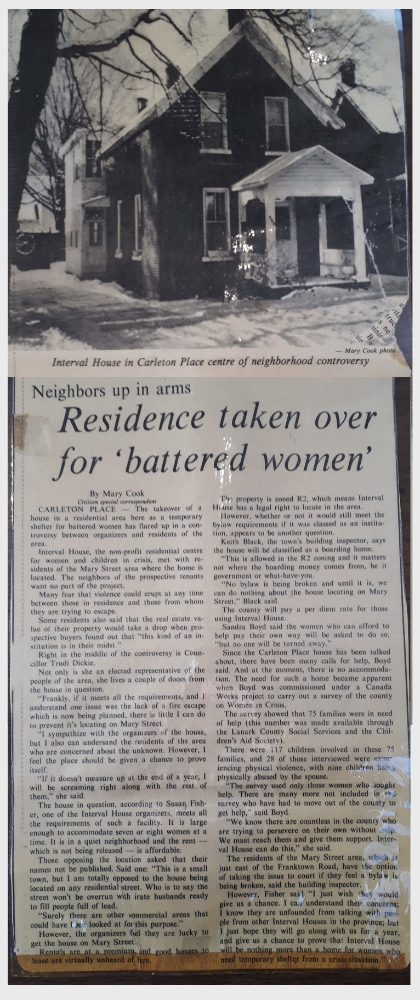The Herstory of Lanark County Interval House & Community Support
Interval House got its beginning following a 1978 Canada Works study sponsored by The Hub in Almonte which determined that women in Lanark County were in need of protection from abusive partners. In December of that year a public meeting was held in Carleton Place and individuals began working on committees. In their initial efforts to secure a house for women in need of safe shelter, the community pushed back. When the group of women found a possible house on Mary Street, the residents worried that such a home in their neighbourhood would lead to streets filled with irate husbands.
Despite this resistance, the home on Mary Street was secured as an emergency shelter for women and children escaping domestic violence with the first six months of rent guaranteed by ‘The Exchange’, a Carleton Place women’s group. The doors opened in May of 1979, although women were in the house by late April, unable to wait any longer for protection.
These visionary women (and men) began our service with the hope that our society would change and the shelter would become redundant. Society has changed in many ways, but the need for services for abused women and their children has increased – or perhaps more accurately, there are more women coming forward to leave their situations. We can thank the founders of LCIHCS for bringing light to an issue that had always existed behind closed doors of the family home and making it a community issue that together we strive to solve.
“My connection with LCIH began in 1979 when I moved to Carleton Place. My decidedly feminist approach to life had begun previously with a face off with patriarchy to keep my son. It was there in Carleton Place that I met the dedicated group of women who had just recently opened a shelter for women. Alongside them, I helped spread awareness through public education in the schools, service clubs, community events and media, as well as raise funds for shelter operation expenses not covered by government. For a year, I was on staff in that position, Public Education Coordinator. I was a board member, committee member, volunteer, and staff member in my time. All of us worked hard at working together. I was especially proud of our work as a collective.
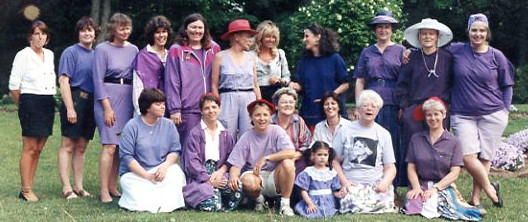
Back: Karen Curran, Donna McKenna, Moira Fox, Dianne Czerwinski, Pat Jeeves, Joan Perkins, Lynette Stanfield, Joni Seligman, Olive Millet, Judy Dupuis, Ella Hamilton
Front: Thelma Peterson, Carole Smith, Gerry Davies, Bev Smith, Victoria, Suzane Mayrand, Joan Gawn, Fern Martin
The intention/hope always was that our services would soon not be required. That we would close. We had fervent hopes that the recognition of this social issue would lessen it within our society. It seemed pretty obvious to us. Instead, the integral need for these shelters has grown and their existence become normalized and an expected part of the structure of our society.”
Karen Phillips Curran
1979-1989 and a few more years in the ’90s
Struggling to Make Ends Meet in the Earliest Years
An orange table in the kitchen of the Mary Street shelter was the centre of most conversations. Someone would cook and the other women would sit around the table, talking and smoking cigarettes. Sometimes those around the table would pitch in and chop veggies, and smoke and talk. With little funds, the shelter relied on donations of food: sometimes duck eggs, milk, sometimes goat milk, even roadkill! If a deer was hit on the side of the road and in good enough shape, the Ministry of Natural Resources would take it the Scotch Corners slaughterhouse and the nice people there would cut and wrap the meat and deliver to the shelter, free of charge.
Until the women got sick of venison stew, venison roast and venison spaghetti…
One day sitting around the orange kitchen table complaining about it, one woman started pounding the table and the others joined in, chanting “WE WANT BEEF! WE WANT BEEF!” Apparently the women at the Almonte United Church heard about the revolt and the next week they delivered three large beef roasts.
Often, headlines like ‘Shelter may have to close its doors due to lack of funds’ would run in the newspaper and supporters would dig deep and send money, sometimes without being asked. Following one such article, The Rosetta Women’s Institute made a donation of $50, the largest one-time donation they had ever made. Also on occasion, a single dollar bill would arrive in the mail. Several years after opening, an older woman came for shelter and told us she had been sending those dollars. Her husband kept a close tab on ‘her’ grocery money but, whenever she could, she sent us those dollars in order to keep our doors open until she could escape.
Interval House initially sought donations from the community to meet the clothing needs for women and children who were seeking refuge at the shelter. This effort inevitably initiated the As Good As New Store in 1980, a volunteer-run second-hand clothing boutique that also provides funds to operate the shelter. As new staff were hired to help run the shelter, the As Good As New revenues helped to pay many salaries. On more than one occasion, staff pay cheques were dependent upon receipts gathered from the store.
“I was a young Social Assistance worker and was doing home visits to complete applications for social assistance when the “story” began. In this capacity I certainly saw a need for a safe haven for women and children, somewhere local. I also met some men in need of a safe place to go to escape persecution of an abusive partner/family, however women by far exceeded the numbers of people I encountered in need of a safe place. When Interval House began, it was a smallish group of committed people who banded together to meet regularly, form a Board, rent a location and start doing what we all knew had to be done.
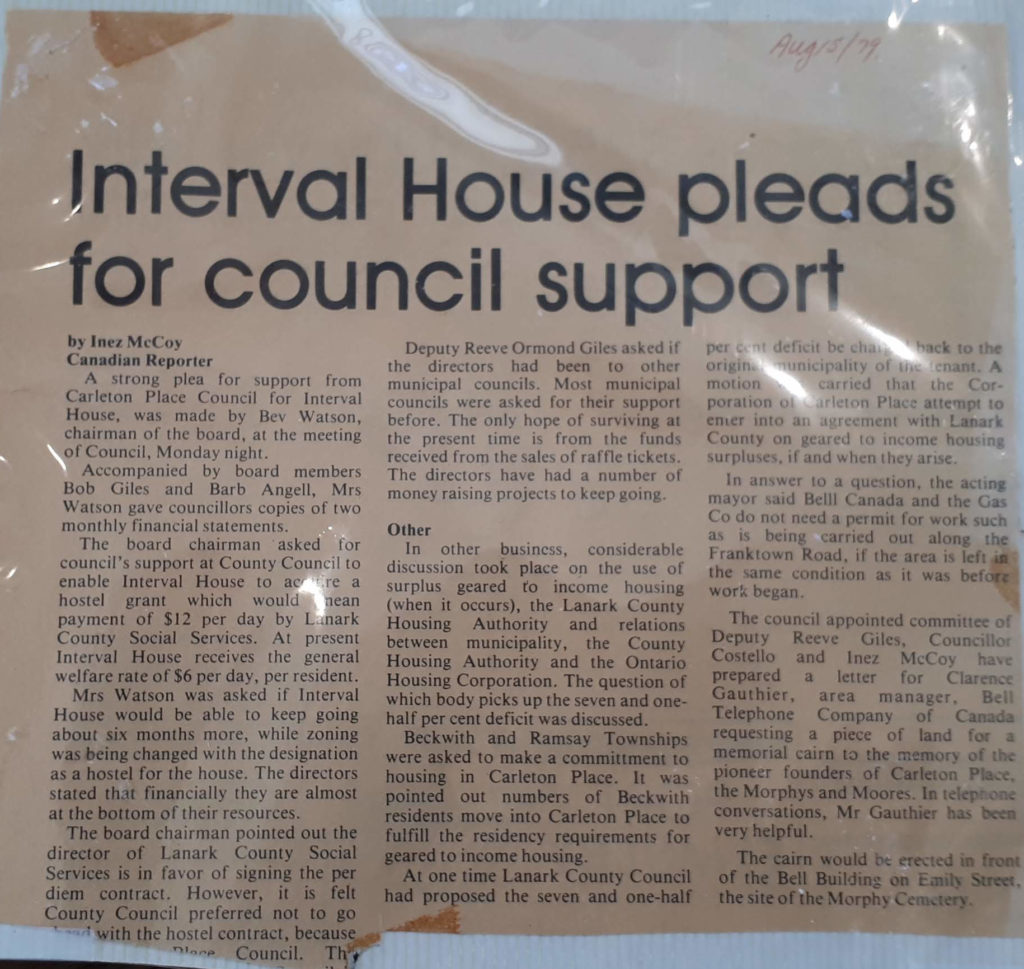 I remember the house on Mary St. filled to excess at times. Initially there was no support in the way of hostel contracts, ongoing funding etc. My young boss at the time, Ray Elgersma was a forward thinking young man and it was he who was responsible for the hostel contracts that were developed in the County for Interval House and other hostels for many other folks who found themselves in difficult situations.
I remember the house on Mary St. filled to excess at times. Initially there was no support in the way of hostel contracts, ongoing funding etc. My young boss at the time, Ray Elgersma was a forward thinking young man and it was he who was responsible for the hostel contracts that were developed in the County for Interval House and other hostels for many other folks who found themselves in difficult situations.
Being young, inexperienced and from a middle class background, my real education had just begun when I started working for Lanark County Social Services. All of these women I met, from all walks of life, helped to shape the woman/worker I was to become. I remember the Interval House Board with all female members… then there were times we had a few men sit, always interesting issues and conversation around that.
I remember one of the men who had worked previously for the United Way in Ottawa, talked a local car sales business out of car that we used as a fundraiser, raising quite a lot of money. I remember when we decided the As Good As New Store would be a way we could fund Interval House ongoing as well as help people when they were leaving to get on their feet. I watched Interval House run as a collective, we initially had directors.
When I left Social Assistance and went on to Developmental Services, Interval House supported my clients as volunteers, or when they needed refuge. Joan Gawn wisely said “everyone can do something to help”, whether it is sticking stamps on envelopes, buying groceries, helping at the Store, etc. I cannot tell you how many times I have used that quote when speaking with people I worked with about the importance of volunteering. Joan Perkins and I worked a deal when I returned to Ontario Works whereby my clients who were being “volun-told” could volunteer at Interval House or in The AGAN Store.
I had a gentleman who volunteered with Interval House as a Handyman. He was an older gentleman who had been laid off from a local company. He was discouraged from not being able to find work. Volunteering for Interval House became a significant part of his life at that time and a great benefit to the shelter. Joan wrote an note in the local paper acknowledging his work after he passed away suddenly.
It seemed for a while that I was always calling Interval at the end of the week. I would always get Joanie’s friendly voice at the end of the line and feel good about handing the phone over to the woman sitting across from me seeking refuge. Some of my most cherished friends and neighbors have been volunteers and staff at Interval House throughout the years (it takes a village). I can remember moving people at very short notice from various communities around Lanark County. My car stuffed with worldly possessions, and sometimes children.
It has been my privilege to have been involved with Interval House for so many years. While I am thankful that we have it, I am sorry that we continue to need it. I am thankful that there is now more government funding available, a few more housing options, official protocols with the police, hospitals, doctors, nurse practitioners, etc. We have come a long way.”
Diane Pearan
Carleton Place Social Assistance Worker
LCIHCS Volunteer from before Mary St until retirement in 2017
Making the Shelter a Home
After a few years on Mary Street and a LOT of fundraising, the staff and volunteers of LCIH were able to raise enough money to purchase the present shelter location. The house was now able to provide shelter for 15 women and children at a time, although it wasn’t a particularly large space. Families needed to share rooms and a single upstairs bathroom.
The agency grew and was not without growing pains. The staff and board did not always agree on what needed to happen. In fact, with many smart and strong women in the room, it was often hard to come to agreement on a variety of topics. But despite the challenges, the agency stayed committed to their purpose of helping women experiencing abuse and continued to grow and move forward.
Around 1989 or 1990, government funding for children’s services was finally secured, and a year later an addition was added to the shelter to give children a playroom. Then, in 1996, the shelter became wheelchair accessible thanks to a grant from the Canada Mortgage and Housing Corporation.
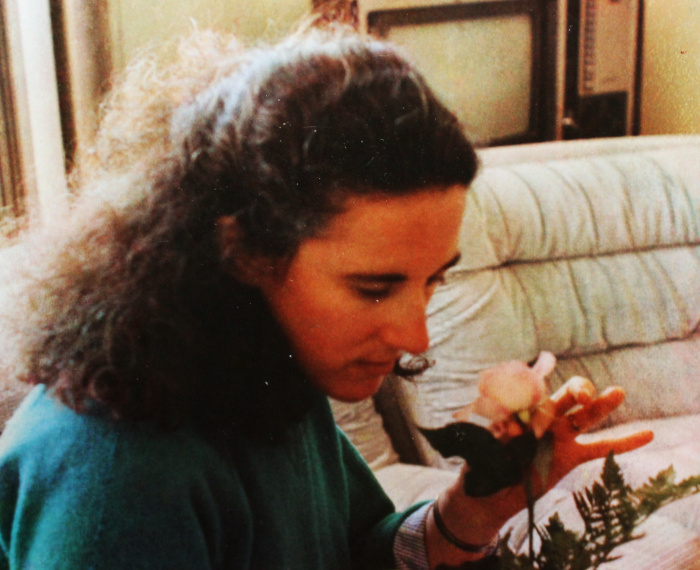 “Lanark County Interval House was opened in 1979. We all hoped that we would work our way out of a job – ending abuse. The shelter moved from Mary Street to its present location in 1983. It was such an exciting change. We had a proper kitchen, a large dining room and a backyard providing a play space for the children with an area to plant a garden. We started to compost. With the huge addition completed in 2008 LCIH grew to 7 bedrooms. The single women and families no longer had to share a bathroom. Families no longer were expected to share a room.
“Lanark County Interval House was opened in 1979. We all hoped that we would work our way out of a job – ending abuse. The shelter moved from Mary Street to its present location in 1983. It was such an exciting change. We had a proper kitchen, a large dining room and a backyard providing a play space for the children with an area to plant a garden. We started to compost. With the huge addition completed in 2008 LCIH grew to 7 bedrooms. The single women and families no longer had to share a bathroom. Families no longer were expected to share a room.
Much has changed but other things remain the same. Mice took an interest in the compost so we scrapped that effort. To this day abuse continues and women still find safety, support and comfort. The shelter was and continues to be an essential service of Lanark County.”
Joni Seligman
Shelter Crisis Counsellor since 1981
Lightning Strikes!
During a huge storm in 1997, Jean and Gerry were working while the lights flickered and the rain poured outside. Then all of a sudden, there was a noise and all the electricity went out. They went around trying to find what was wrong, then heard a banging on the side door. When they responded the neighbour was there and told them the roof was on fire. The shelter had been hit by lightning!
They quickly called everyone out of their rooms and went outside. Jean had a green minivan and everyone got in it, far more people than seat belts but remember, it’s POURING rain. Jean drove out of the parking lot and just went next door. In the time it took her to get all the women a safe distance from the house, the fire department was on site and people had come out onto the street to watch. A woman who lived just down the street invited the shelter staff and residents to go to her house until they could figure out what to do next. There was no emergency plan in place. They needed to find a place the women could sleep. Later that evening, someone in the community offered the staff and residents a place to stay temporarily, a little place on Lake Avenue, where they remained until the house was repaired from the fire. As a result of that, there’s now an emergency plan in place to go to basement of the All Nations Church on Bridge Street beside As Good As New.
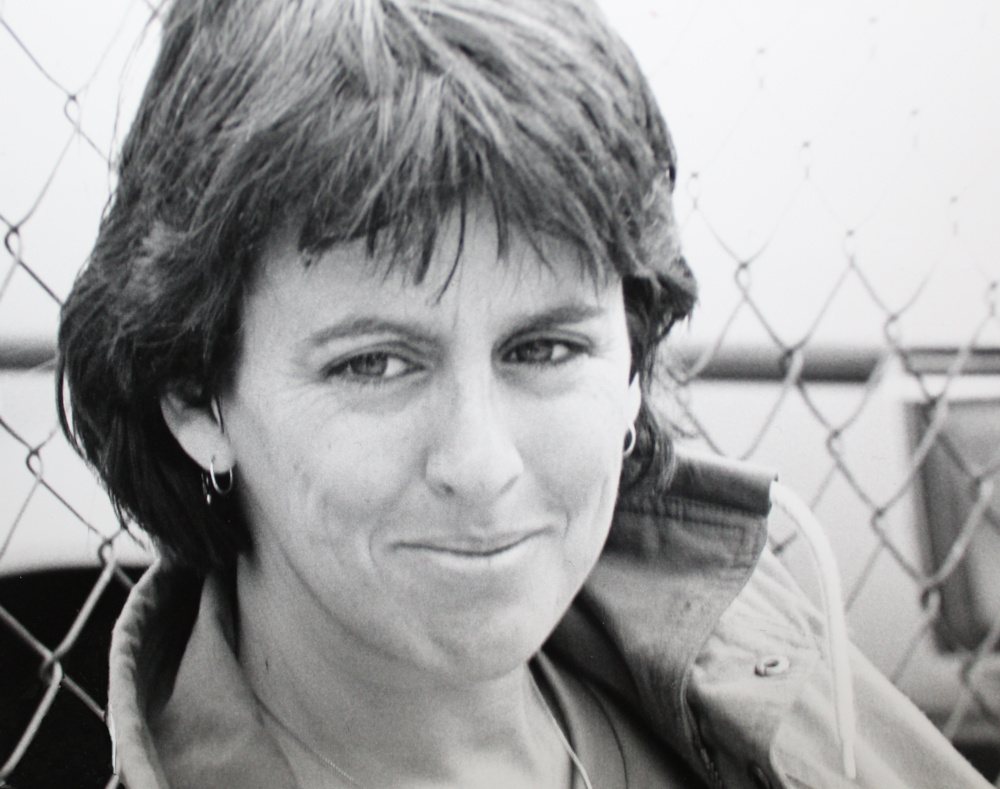 “I was prompted to apply for a job at LCIH after reflecting on my own experience of being sexually assaulted twice while traveling overseas. The oppression of women as a class suddenly came to consciousness and I wanted to help with the liberation project. That said, I had no idea what I was getting into. I had no idea what was happening to women behind the closed doors of their houses. Men’s cruelty and brutality to women seemed to know no bounds.
“I was prompted to apply for a job at LCIH after reflecting on my own experience of being sexually assaulted twice while traveling overseas. The oppression of women as a class suddenly came to consciousness and I wanted to help with the liberation project. That said, I had no idea what I was getting into. I had no idea what was happening to women behind the closed doors of their houses. Men’s cruelty and brutality to women seemed to know no bounds.
My first learning was about the depth and scope of the problem. My second learning was that the abuse of women is held in place by public institutions (police, courts, child welfare, etc.) riddled with discriminatory policies and practices. My third learning was that as women we are largely oblivious to our assigned second-class status, and in our blindness often collude in our own oppression.
LCIH was an exciting place to work, to think and to take action for change. We helped women. We changed ourselves. And we acted politically, challenging the structures that collude to keep women entrapped with abusive men. We were women helping women; all in the same boat; envisioning a world where women are free to determine the course of our own lives. It was a very special time.”
Donna F. Johnson
Coordinator, Community Support Program,1986-2002
“As an organization Lanark County Interval House and Community Support empowers the women who call, come to the home, and/or need support in the community. I saw first hand how they, and their children, blossomed with this kind of approach. One of my goals as Volunteer Coordinator was to treat our volunteers the same way . . . to empower them in their role at Interval House, and as individuals. I learned that this is the best way to treat all people. Whether it’s with service users, coworkers, volunteers, strangers, professionals, acquaintances, friends or family it just makes sense to me. It feels good, and it comes from a place of kindness. It’s a belief in the goodness, worthiness and personal growth of each individual. It’s positive, and it can make a difference in how a person moves forward. It’s how I like to be treated.”
Dianne Czerwinski
Volunteer Program Coordinator for 5 years in the early ’90s
Big Growth for Interval House
In 2002, the first Community Support office (then called Outreach) was opened in Carleton Place and a couple years later when a lack of funding led to the closure of the Sexual Assault Centre in Carleton Place, LCIH established a part-time Sexual Assault Support Program to try to fill the gap in services. Then in 2006 the Perth office for Community Support opened, increasing accessibility of our services to women in other parts of the county.
Throughout the years, the group of women involved with Interval House grew and when collectives get bigger, there are more layers of thought, knowledge and opinion to navigate. Eventually the collective shifted to a modified collective and then eventually to a hierarchical structure with Pat Jeeves hired as the first Director. Pat had long been involved with the shelter as a board member and had been called on in the past for her perspective as a social worker. Eventually, the staff of Interval House were unionized.
In 2007, Erin Lee was hired as the Executive Director and Pat Jeeves moved into a project management role, spearheading the major shelter renovation funded by a one-time grant from the Ministry of Community and Social Services. The shelter moved temporarily to an old red brick house on MacArthur street during the renovation and the admin team moved above the As Good As New Store while the renovation was in progress.
We hosted our first Violet Femmes event in 2007 and this major annual fundraiser has continued to grow, now raising seven times what it did in its first year. The staff also participated in Step It Up Ontario in 2007, refueling our passion for political activism.
In November of 2008 the newly renovated shelter opened with 7 private bedrooms each with their own bathroom. The shelter was now set up for easier community living with a big kitchen, kids play area and fully wheelchair accessible. This freed up the century-old home that had been housing women and children, and the administration staff of LCIH moved into that space although Public Education and the Volunteer Program stayed above AGAN as they had been there for many years. The space above AGAN was fondly referred to as Vera’s after a local woman who had lost her life at the hands of her partner. About three years after the renovation, Public Education and Volunteer Program joined the admin team in the old shelter space and Vera’s was revamped into an apartment which was rented out, bringing in a little bit more money to help the operations of the agency.
“The importance of communication and the recognition that change is very difficult for all of us stand out for me as my most significant learning from my time at LCIH.
Ensuring the community messaging about violence against women was constant, consistent, and accessible was the focus of the Public Education Committee. This may sound obvious but we continually asked ourselves is our message was saying what we wanted and reaching who we wanted. This was also so important to remember in working with women in the shelter, on the crisis line, in community support groups and on the sexual assault crisis line. We needed to listen, reflect, and communicate with every woman and among ourselves to ensure we supported and worked with them to meet their needs within the context of LCIH.
Change is hard and scary for all of us, and takes time. Sometimes a lot of time and often comes in small steps after much thought, reflection, anger and frustration. We needed to recognize this in how we worked together, how we worked with women, and how we worked in the broader community. Being open, creative, flexible, supportive, strong but principled trying to meet everyone’s needs can be challenging.”
Hinda Goldberg
Board Member and Public Education Committee Member and Chair 1994 – 1998
Co-Coordinator with Donna McKenna – 1998 – 2002
Building Relationships & Activating the Community
Around this time there was a major focus on developing relationships within the community to support the agency. We engaged with our local MPP, the local OPP, town councils, county council and local hospitals. It wasn’t just about asking for more money, it was about working together to support the women of Lanark County and make lasting change. As a direct result of this relationship building, we’ve had the opportunities to present to the Warden’s Caucus, to meet with government ministers and to make violence against women everybody’s issue.
We became part of the the local chamber and connected with business groups with the intention of building our community together. This led to a training with estheticians and hairdressers, sharing with them the signs of abuse to watch for with their clients and how to respond properly. We supported local abuse survivor Laurie Jorgensen when she published her book, Motorcycle Memoir. We really started working with our local planning councils on the topics of Indigenous people and LGBTQ+ communities.
In May 2009, funding from the Status of Women Canada led to the launch of our youth project “Where is the Love?” teaching youth about dating violence and healthy relationships. The objective of this project was to prevent future violence and abuse and was followed in 2011 by a three year project “Truth for Rural Youth”, also funded by the Status of Women Canada. This project built on the exciting momentum of “Where is the Love?” and created numerous online resources, conferences and workshops for Lanark County youth. Despite the termination of formal funding for our youth conferences, we’ve been able to sustain them thanks to the support of local Civitan Clubs, the Perth & District Community Foundation and United Way Lanark County.
Through collective voice we were able to negotiate some funding from the Ministry of Attorney General for the Family Court Support Program. With the retirement of Joan Perkins, long-time coordinator of the Volunteer Program, the agency established a Resource Development position. Around that same time, our outreach services were able to grow and move into a larger space thanks to a substantial donation from a community business leader.
Although we were far from achieving the original goal of ending violence against women, by the late 2000s LCIHCS had successfully gotten the county talking about violence against women, a topic that was never discussed publicly when the brave founders started their work thirty years before.
“As the current ED of Lanark County Interval House and Community Support I have been gifted with many learnings from women, children, youth and community members across the gender spectrum. From film creation, to youth conferences, marches and tragedies I continue to marvel at the strength of community.
In our evolution I have learned about the significance of relationships. Relationships shape, inform, guide and support this journey. Making room for a hand up and approaching the work from a yes and instead of a yes but continues to drive our political action, education, and commitment to the equality rights of women.
In solidarity and with much pride sisters.“
Erin Lee
Executive Director 2007-Present
Evolving Feminism & An Inclusive Community
Working throughout Lanark County and beyond to raise public awareness has been a focus in the more recent years. As a result of the well known murders in 2015 and the subsequent murders in 2016 in both Lanark County and Lennox and Addington County, we formed the Rural Forums and brought counties together to talk about violence in rural Eastern communities. From this work came the See It. Name It. Change It. campaign which continues today. We tried to have events in communities across the county so that women would know they were able to access our services. There was the Erace Violence run in Middleville and spa wellness days in a number of communities. Then there was the 2016 Perth Polar Bear Plunge where we raised $28K in a single day – the biggest third party fundraiser to date.
The agency started to implement harm reduction within our work with women and reviewed all of our policies and guidelines, resulting in becoming a wet shelter in September of 2017. We are now a Naloxone training site and have safe use supplies available as we recognize that we’re not in the role to dictate the healing process of women. We are also committed to working from a trauma informed approach and are one of the first agencies in our county committed to working from that perspective.
We’ve become experts at running events on very low budgets to educate the people of our community, like the launch of the Lanark County Commitment to Truth & Reconciliation. We continue to build our capacity and knowledge to ensure that our services reflect the people who live in our community.
Most recently, we saw the results of our years of relationship building come together with the launch of the first Second Stage Housing for women in Lanark County. With Tiree in the lead as a generous corporate sponsor and extensive support from the County of Lanark, the Mississippi Mills & Carleton Place Rotary Club and many other businesses, local municipalities and private donors we were able to create this essential service without government funding. Thinking back to the days the founding women had to rely on roadkill and single dollar bill donations, we’ve come a long way.
Lanark County Interval House & Community Support remains active and present ensuring Take Back the Night, annual vigils, Pride, and advocacy alongside all women; rural women, women of colour, Indigenous women, immigrant women, LGBTQ+ women, senior women and women who identify as differently abled is ongoing. We are committed to an anti-racist, anti-oppressive, trauma informed, harm reduction approach and framework throughout the agency. We work creatively with systems with a focus on breaking down barriers and demanding for meaningful permanent change. Choice is central to our work from sex worker rights to transgender inclusion. Perhaps feminism looks a little different today than it did forty years ago but the values of equality remain the same.
LCIH and CS will be forever grateful to women for sharing their journey and trusting the agency to protect their human rights and their right to safety. Working in solidarity is part of our fabric and ending violence against women, children, youth and girls remains our goal.
May we achieve it in the next forty years.
Check out the 40th Anniversary Our Stories Series on our blog:
Spring/Summer 2024 Newsletter
Click here to read our SpringSummer 2024 Newsletter
Introducing LCIHCS’ Perseverance Pantry
We are so excited to introduce one of the newer LCIHCS programs: The Perseverance Pantry! Introduced in February to tackle food insecurity and the cost of living, The Perseverance Pantry provides women and children with food and hygiene items as they recover from...
Why Women Can’t Be Beat
Have you ever wondered where our slogan “Women Can’t Be Beat” comes from? To many, this slogan is an empowering testament to the strength of women. To others, the slogan may come across as crass or jarring. Both opinions may be true. “The slogan was meant to be...
Corporate Support for LCIHCS: Eaton Industries 2020 Stover Award Winner Donates Prize Money to Help Women in Need
Recently LCIHCS was honoured to receive a generous donation on behalf of Benjamin van der Ham, the 2020 Stover Award Winner at Eaton Industries Canada’s distribution centre in Perth. Ben was “honoured to be nominated” by his peers for the award and was “humbled” to be...
HERSTORY: As Good As New Store
While shopping at As Good As New (AGAN), it is easy to forget the difficult beginnings that made the organization what it is today. We’d like to take this opportunity to share with you the HERstory of AGAN and highlight some memories of our volunteers.
Our Stories: Jean – Shelter Manager
I have worked at Lanark County Interval House & Community Support for thirty years and throughout that period there have been lots of changes!I have always been interested in women’s issues and having grown up in a home where my father was very abusive...
This herstory has been put together through the use of various documents from past celebrations of LCIHCS, and the memories of current and past staff and volunteers. If you see any errors in what is shared below or know of another story that you feel would be nice to include, please contact the Communications & Volunteer Program Coordinator at volunteer@lcih.com.

